
Structural formula
| Business number | 05YR |
|---|---|
| Molecular formula | C7H5BRO2 |
| Molecular weight | 201.02 |
| label |
p-bromobenzoic acid, p-bromobenzoic acid, p-bromobenzoic acid, p-Bromobenzoic acid, aromatic compounds, Aromatic carboxylic acids, amides, Anhydrides and salts, benzoic acid, organic acids, amino acids and esters, bromine compounds, analytical chemistry, Functional Materials, carbonyl compounds, carboxylic acid |
Numbering system
CAS number:586-76-5
MDL number:MFCD00002529
EINECS number:209-581-7
RTECS number:DG4448050
BRN number:1906923
PubChem number:24849747
Physical property data
1. Physical property data
1. Properties: white or light pink crystal.
2. Melting point 254.5℃.
3. Relative density 1.894 (20/4℃).
4. Solubility Soluble in alcohol and ether, slightly soluble in water.
5. Relative density (25℃, 4℃): 1.8915
6. Gas phase standard claims heat (enthalpy) (kJ·mol-1) : -290.4
7. Crystal phase standard claims heat (enthalpy) (kJ·mol-1): -378.3
Toxicological data
Acute toxicity:
Classification-related LD/LC50 value:
Oral LD50 1059mg/kg(mus)
Ecological data
3. Ecological data:
1. Other harmful effects: This substance may be harmful to the environment, and special attention should be paid to water bodies.
Molecular structure data
Molecular property data:
1. Molar refractive index: 40.87
2. Molar volume (cm3/mol): 118.1
3. etc. Zhangratong (90.2K): 319.8
4. Surface tension (dyne/cm): 53.7
5. Polarizability (10-24cm3): 16.20
Compute chemical data
IV. Calculated chemical data:
1. Hydrophobic parameter calculation reference value (XlogP): 2.9
2. Number of hydrogen bond donors: 1
3. Number of hydrogen bond acceptors: 2
4. Number of rotatable chemical bonds: 1
5. Topological molecular polar surface area (TPSA): 37.3
6. Number of heavy atoms: 10
7. Surface charge: 0
8. Complexity: 128
9. Number of isotope atoms: 0
10. Determine the number of atomic stereocenters: 0
11. The number of uncertain atomic stereocenters: 0
12. The number of determined chemical bond stereocenters: 0
13. The number of uncertain chemical bond stereocenters: 0
14. Number of covalent bond units: 1
Properties and stability
Stability and reactivity:
Materials to avoid: Oxides, bases.
Products to be decomposed: carbon monoxide and carbon dioxide, hydrogen bromide.
Storage method
Storage:
Seal the container and store it in a sealed main container in a cool, dry place.
Synthesis method
1. Preparation method: Obtained from oxidation and acidification of p-bromotoluene. Mix p-bromotoluene, water and potassium hydroxide, heat and boil, add potassium permanganate in portions, reflux for 4 hours, filter and acidify to obtain crude product. Then dissolve it in dilute ethanol with ammonia water, filter it, neutralize it with hydrochloric acid, and wash it with water to get the finished product.
Purpose
2. Usage: organic synthesis intermediate.

 微信扫一扫打赏
微信扫一扫打赏

